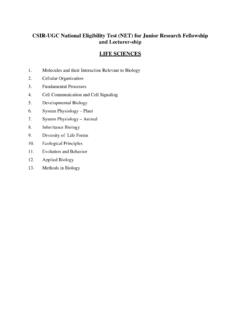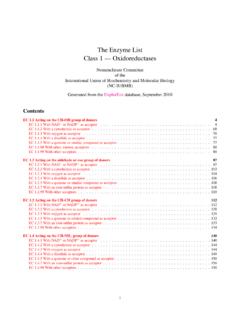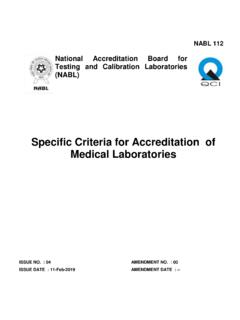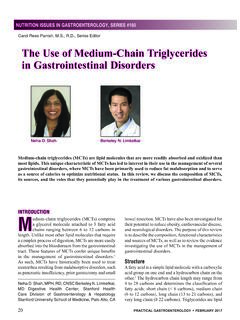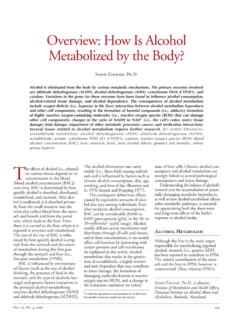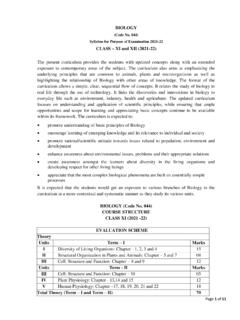Transcription of Biology, Chemistry and Physics - GOV.UK
1 Biology, Chemistry and Physics GCSE subject content June 2015 2 Contents Subject Content 4 Introduction 4 Subject aims and learning outcomes 4 Working scientifically 7 Biology 9 Cell biology 10 Transport systems 11 Health, disease and the development of medicines 12 Coordination and control 13 Photosynthesis 15 Ecosystems 16 Inheritance, variation and evolution 17 Chemistry 20 Atomic structure and the Periodic Table 20 Structure, bonding and the properties of matter 22 Chemical changes 23 Energy changes in Chemistry 25 The rate and extent of chemical change 26 Organic Chemistry 27 Chemical analysis 27 Chemical and allied industries 29 Earth and atmospheric science 31 Physics 33 Energy 34 3 Forces 35 Forces and motion 36 Waves in matter 37 Light and electromagnetic waves 38 Electricity 39 Magnetism and electromagnetism 41 Particle model of matter 42 Atomic structure 43 Space Physics 44 Appendix 1 46 Appendix 2 48 Appendix 3 49 Appendix 4 50 4 Subject Content Introduction These GCSE subject criteria set out the knowledge, understanding, and skills for GCSE specifications in biology, Chemistry and Physics to ensure progression from key stage 3 national curriculum requirements and the possibility of development into A level.
2 They provide the framework within which awarding organisations create the detail of the subject specifications. Subject aims and learning outcomes This document sets out the learning outcomes and content coverage required for GCSEs in the sciences. In subjects such as the sciences, where topics are taught in progressively greater depth over the course of key stage 3 and key stage 4, GCSE outcomes may reflect or build upon subject content which is typically taught at key stage 3. There is no expectation that teaching of such content should be repeated during the GCSE course where it has already been covered at an earlier stage. GCSE study in the sciences provides the foundations for understanding the material world. Scientific understanding is changing our lives and is vital to the world s future prosperity, and all students should be taught essential aspects of the knowledge, methods, processes and uses of science.
3 They should be helped to appreciate how the complex and diverse phenomena of the natural world can be described in terms of a small number of key ideas relating to the sciences which are both inter-linked, and are of universal application. These key ideas include the use of conceptual models and theories to make sense of the observed diversity of natural phenomena the assumption that every effect has one or more cause that change is driven by differences between different objects and systems when they interact that many such interactions occur over a distance without direct contact that science progresses through a cycle of hypothesis, practical experimentation, observation, theory development and review that quantitative analysis is a central element both of many theories and of scientific methods of inquiry. 5 These key ideas are relevant in different ways and with different emphases in the three subjects: examples of their relevance are given for each subject in the separate sections below for biology, Chemistry and Physics .
4 GCSE specifications in the three sciences studied concurrently should enable students to: develop scientific knowledge and conceptual understanding through the specific disciplines of biology, Chemistry and Physics develop understanding of the nature, processes and methods of science, through different types of scientific enquiries that help them to answer scientific questions about the world around them develop and learn to apply observational, practical, modelling, enquiry and problem-solving skills, both in the laboratory, in the field and in other learning environments develop their ability to evaluate claims based on science through critical analysis of the methodology, evidence and conclusions, both qualitatively and quantitatively. Furthermore the sciences should be studied in ways that help students to develop curiosity about the natural world, insight into how science works, and appreciation of its relevance to their everyday lives.
5 The scope and nature of such study should be broad, coherent, practical and satisfying, and thereby encourage students to be inspired, motivated and challenged by the subject and its achievements. The two main dimensions of the content The ways in which GCSE specifications in the three sciences should enable students to show their understanding of the concepts and methods of science are spelt out below in two main sections. The first section explains the main ways in which working scientifically should be developed and assessed. Specifications should encourage the development of knowledge and understanding in science through opportunities for working scientifically. Awarding organisations should identify in their assessment strategy how, over a cycle of assessments, they will ensure that working scientifically is developed and assessed through the subject content. The second section sets out the key ideas and subject contents for biology, Chemistry and Physics .
6 These content sections also set out the depth of treatment for both teaching and learning. Awarding organisations specifications should be designed to set out the level of understanding which pupils are expected to acquire. 6 The content sections also set out the mathematical skills required for each science discipline. In order to be able to develop their skills, knowledge and understanding in science, students need to have been taught, and demonstrate competence, to select and apply the appropriate areas of mathematics relevant to the subject as set out under each topic and the mathematical skills listed in appendix 3. The mathematics should be at levels up to, but not beyond, the requirements specified in GCSE mathematics for the appropriate tier. All mathematics content must be assessed within the lifetime of the specification. Four Appendices provide further details about (1) equations in Physics ; (2) units in science; (3) mathematical skills; and (4) gives a list of apparatus and techniques.
7 7 Working scientifically This second section explains, with both general and subject-specific examples, the main ways in which working scientifically may be developed and assessed. 1. Development of scientific thinking understand how scientific methods and theories develop over time use a variety of models such as representational, spatial, descriptive, computational and mathematical to solve problems, make predictions and to develop scientific explanations and understanding of familiar and unfamiliar facts appreciate the power and limitations of science and consider any ethical issues which may arise explain everyday and technological applications of science; evaluate associated personal, social, economic and environmental implications; and make decisions based on the evaluation of evidence and arguments evaluate risks both in practical science and the wider societal context, including perception of risk in relation to data and consequences recognise the importance of peer review of results and of communicating results to a range of audiences.
8 2. Experimental skills and strategies use scientific theories and explanations to develop hypotheses plan experiments or devise procedures to make observations, produce or characterise a substance, test hypotheses, check data or explore phenomena apply a knowledge of a range of techniques, instruments, apparatus, and materials to select those appropriate to the experiment carry out experiments appropriately having due regard to the correct manipulation of apparatus, the accuracy of measurements and health and safety considerations recognise when to apply a knowledge of sampling techniques to ensure any samples collected are representative make and record observations and measurements using a range of apparatus and methods evaluate methods and suggest possible improvements and further 8 investigations. 3. Analysis and evaluation Apply the cycle of collecting, presenting and analysing data, including.
9 Presenting observations and other data using appropriate methods translating data from one form to another carrying out and represent mathematical and statistical analysis representing distributions of results and make estimations of uncertainty interpreting observations and other data (presented in verbal, diagrammatic, graphical, symbolic or numerical form), including identifying patterns and trends, making inferences and drawing conclusions presenting reasoned explanations including relating data to hypotheses being objective, evaluating data in terms of accuracy, precision, repeatability and reproducibility and identifying potential sources of random and systematic error communicating the scientific rationale for investigations, methods used, findings and reasoned conclusions through paper-based and electronic reports and presentations using verbal, diagrammatic, graphical, numerical and symbolic forms.
10 4. Scientific vocabulary, quantities, units, symbols and nomenclature use scientific vocabulary, terminology and definitions recognise the importance of scientific quantities and understand how they are determined use SI units ( kg, g, mg; km, m, mm; kJ, J) and IUPAC chemical nomenclature unless inappropriate use prefixes and powers of ten for orders of magnitude ( tera, giga, mega, kilo, centi, milli, micro and nano) interconvert units use an appropriate number of significant figures in calculation. 9 Biology Biology is the science of living organisms (including animals, plants, fungi and microorganisms) and their interactions with each other and the environment. The study of biology involves collecting and interpreting information about the natural world to identify patterns and relate possible cause and effect. Biological information is used to help humans improve their own lives and strive to create a sustainable world for future generations.










